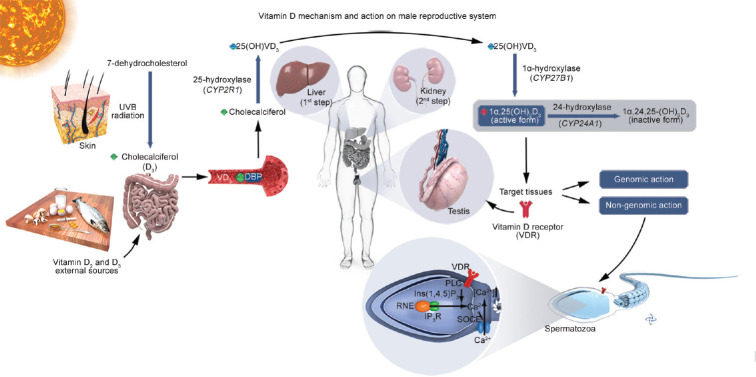Figure 3.
Vitamin D (VD3) mechanism and action on male reproductive system. After sun exposure, the first step of VD3 synthesis occurs in the skin, where ultraviolet B radiation converts 7-dehydrocholesterol into cholecalciferol (vitamin D3). Vitamin D2 and D3 coming from food sources or external administration, are absorbed in the gut and transported to the bloodstream, where cholecalciferol couples with VD3 binding protein (DBP) and is carried to the liver. Cholecalciferol (vitamin D3) is biologically inactive, and must undergo two hydroxylation steps to form the active 1α,25-dihydroxy-vitamin D3 (1α,25(OH)2D3). The first step is a reaction mediated by the hepatic CYP2R1 gene that codifies the 25-hydroxylase enzyme. The second step is conducted by renal CYP27B1 that codifies the enzyme 1α-hydroxylase, leading to the formation of the biological active form, 1α,25(OH)2D3, responsible for a multitude of genomic and nongenomic actions through binding and activating VD3 receptor (VDR) in many target tissues, including Leydig and Sertoli cells in testis, their precursor cells and spermatozoa. 1α,25(OH)2D3 can be inactivated by the 24-hydroxylase enzyme (codified by CYP24A1 gene), transforming into the inactive form 1α,24,25-trihydroxy-vitamin D3 (1α,24,25-(OH)3D3). The nongenomic effect of VDR in human spermatozoa occurs when the active form, 1α,25(OH)2D3 activates VDR in the neck region inducing PLC activation leading to IP3 production which subsequently opens IP3R-gated calcium channels in the RNE increasing intracellular Ca2+ concentration. Subsequently, the initial Ca2+ release from RNE might be supported by SOCE.38 VD3: vitamin D; CYP: cytochrome P450 gene superfamily; CYP2R1 gene: cytochrome P450 family 2 subfamily R member 1; CYP27B1 gene: cytochrome P450 family 27 subfamily B member 1; CYP24A1 gene: cytochrome P450 family 24 subfamily A member 1; VDR: vitamin D receptor; PLC: phospholipase C; IP3: Inositol 1,4,5-trisphosphate; IP3R: inositol 3-phosphate receptor; RNE: redundant nuclear envelope; SOCE: store-operated calcium entry. Illustration was developed by Androscience®.

